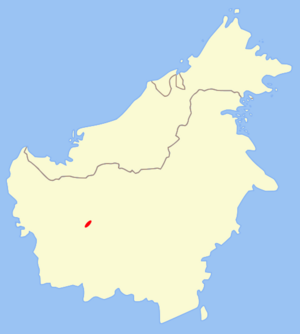Bornean flat-headed frog facts for kids
Quick facts for kids Bornean flat-headed frog |
|
|---|---|
| Conservation status | |
| Scientific classification | |
 |
|
| Map of Borneo depicting range of Bornean flat-headed frog |
The Bornean flat-headed frog (Barbourula kalimantanensis) is a very special type of frog. It belongs to the family Bombinatoridae. For many years, scientists believed this frog was the only one in the world that had no lungs. This meant it had to breathe only through its skin!
However, in 2024, scientists used a special kind of X-ray scan called micro CT scanning. With this technology, they discovered that the Bornean flat-headed frog actually has extremely tiny lungs.
Djoko Iskandar, a scientist from Indonesia, was the first person to describe this frog. He studied a single frog to learn about it. At first, he didn't know the frog was lungless. He found this out later when he was on an expedition with another scientist, David Bickford. Bickford and his team were able to study some of the frogs. They carefully looked inside and discovered that the frogs seemed to have no lungs.
Because it breathes mostly through its skin, this frog is much flatter than most other frogs. Its stomach, spleen, and liver take up most of the space where lungs would normally be. Being flat helps the frog soak up more oxygen through its skin. It also helps it avoid being washed away in the fast-moving rivers where it lives.
Contents
What Does This Frog Look Like?
Female Bornean flat-headed frogs can grow to about 77 mm (3 in) long from their snout to their rear end. Males are usually a little smaller. This frog has a very flat body. Its head is wide and has a rounded snout. Its legs are strong, and both its hands and feet have full webbing, like a duck's foot.
The skin on its back is smooth. It has small bumps, called tubercles, on its rear and hind legs. The skin on its belly is also smooth. The frog is usually brown with black spots or patterns.
Where Does This Frog Live?
This frog lives in water. It prefers cold, clear, and fast-flowing rivers. These rivers are found in remote areas of the rainforests in Kalimantan. Kalimantan is the Indonesian part of the large island of Borneo.
So far, scientists have only found this frog in two places. Both of these places are in the Kapuas River basin.
Why Is This Frog Important?
The IUCN (International Union for Conservation of Nature) has listed the Bornean flat-headed frog as Endangered. This means it is at a high risk of disappearing forever.
The biggest threat to this frog is the loss of its home. The river habitats where it lives are being badly damaged. This happens because of mining and other human activities on the island. These activities can make the river water cloudy and add toxic metals, which are harmful to the frogs.
See also


